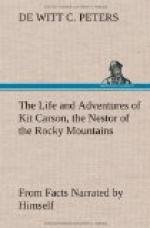We cannot resist the impulse which here struggles for utterance. Look upon that little steamboat as it ascends the mighty Missouri bearing in its bosom the man who was destined to point out the hidden paths of the mighty West; to mount and record the height of the loftiest peak of the American monster mountain chain; to unfold the riches of the interior of a great and glorious empire to its possessors, and, finally, to conquer with his good sword, preparing the way for its annexation to his country, the richest soil and fairest land on earth, thus adding one more glorious star to the original thirteen of 1776; a star, too, of the very first magnitude, whose refulgent brightness shines clear, sparkling and pure for the Truth of Sacred Writ and American Liberty. On the deck of that little steamboat, the two men, the one the master mind, the giant intellect, the man of research and scholastic strength, the scientific engineer; the other, than whom his superior as an American mountaineer was not living, stood, uninterested spectators of each other; and, each, unconscious why they had been permitted to enter the same cabin. The Christian student of American history cannot pass by this simple circumstance without seeing Heaven’s wisdom in such a coincidence; namely, Kit Carson for the first time in sixteen years bending his steps to his boyhood home just as his sixteen years of mountaineer skill and experience were required by one of the master workmen of American Engineering, about to enter upon the exploration of inland North America.
Kit Carson wandered over the boat, studying its mechanism, admiring the machinery, which, so like a thing of life, subserved the interests of human life; watched with quiet reserve the faces and general appearance of his fellow-passengers; occasionally, modestly addressed an acquaintance, for some present were known to him; and, finally singled out from among the strangers a man on whose face he thought he discovered the marks of true courage, manhood and nobility of character. The impression which Kit Carson had thus received, was nothing fleeting. The eagle eye, the forehead, the form, the movements, the general features, the smile, the quiet dignity of the man, each and all of these attributes of his manhood had been carefully noted by the wary and hardy mountaineer, and had not failed to awaken in his breast a feeling of admiration and respect. While on this boat Kit Carson learned the fact that the man, whom he had thus studied, was Lieutenant John C. Fremont of the U.S. corps of topographical engineers; also, that Lieutenant Fremont had been earnestly seeking Captain Drips, an experienced mountaineer, but, that he had been disappointed in finding him. Upon learning this, Kit Carson fell into a deep reverie which lasted some little time, when, having brought it to a conclusion, he approached Lieutenant Fremont and modestly introducing himself, said:
“Sir! I have been some time in the mountains and think I can guide you to any point there you wish to reach.”




